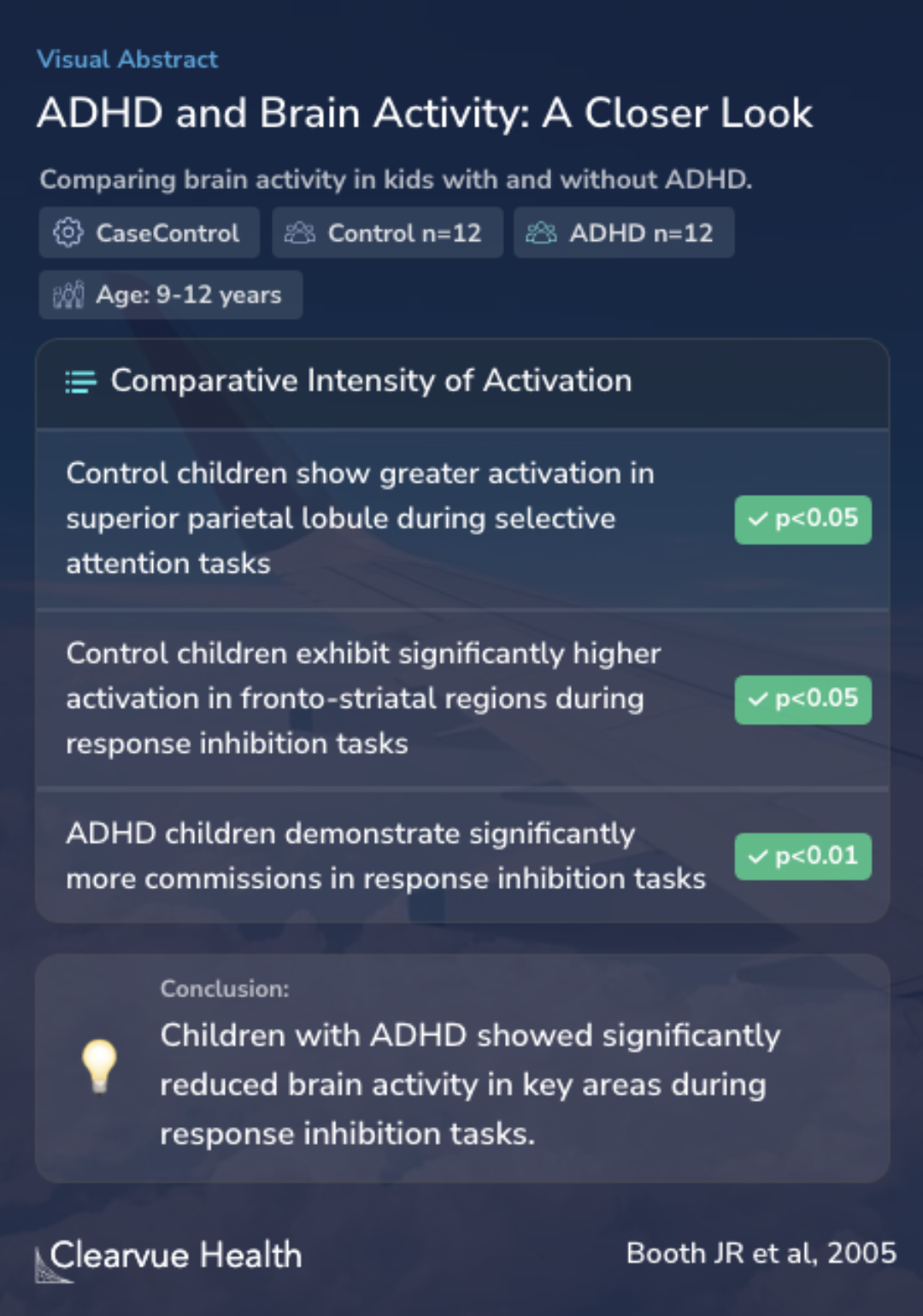Larger deficits in brain networks for response inhibition than for visual selective attention in attention deficit hyperactivity disorder (ADHD)
ADHD and Brain Activity: A Closer Look
Booth JR, Burman DD, Meyer JR, Lei Z, Trommer BL, Davenport ND, Li W, Parrish TB, Gitelman DR, Mesulam MM

Objectives
The study aimed to investigate brain activation differences between children with and without ADHD during cognitive tasks. The focus was on understanding how these differences manifest in specific brain areas during tasks that require visual selective attention and response inhibition. This investigation was intended to shed light on the neurological underpinnings of ADHD, particularly in how children with this condition process and respond to various cognitive demands compared to their non-ADHD counterparts.
Background: Brain activation differences between 12 control and 12 attention deficit hyperactivity disorder (ADHD) children (9- to 12-year-olds) were examined on two cognitive tasks during functional magnetic resonance imaging (fMRI).
Methods
To explore these differences, the study employed functional magnetic resonance imaging (fMRI) to observe the brain activity of two groups of children, aged 9 to 12 years: one group with ADHD and one without. The children were engaged in two types of cognitive tasks while their brain activity was monitored. The first task involved visual selective attention, where participants were asked to identify a specific target (a red triangle) amid various distractors. The second task was a go/no-go task designed to measure response inhibition, requiring participants to respond or withhold their response based on certain cues.
Method: Visual selective attention was measured with the visual search of a conjunction target (red triangle) in a field of distractors and response inhibition was measured with a go/no-go task.
Results
The study observed that in tasks requiring focused attention, children without ADHD displayed slightly more activity in a specific brain area called the superior parietal lobule compared to children with ADHD. However, these differences were not very large. The contrast became more pronounced in tasks that demanded stopping and thinking before acting, such as in situations where one must refrain from pressing a button. Here, children without ADHD showed significantly higher levels of brain activity in various regions, including those involved in making decisions and controlling physical movements.
Further examination revealed that children without ADHD had notably higher activity in crucial brain areas during tasks that required careful consideration and control. This increase in activity was particularly evident in the fronto-striatal regions, which are crucial for planning and executing actions.
Results: There were limited group differences in the selective attention task, with control children showing significantly greater intensity of activation in a small area of the superior parietal lobule region of interest. There were large group differences in the response inhibition tas...
Conclusions
The findings suggest that children with ADHD exhibit less brain activity in critical areas needed for controlling impulsive actions, supporting the idea that difficulties in self-control are a core challenge in ADHD. This reduction in brain activity was extensive and particularly noticeable in tasks that required response inhibition, aligning with the notion that children with ADHD find it especially hard to hold back their immediate responses.
This conclusion is in line with a larger body of research, including a meta-analysis by Cortese et al., which analyzed brain imaging data from 55 studies to explore differences in brain activity in individuals with ADHD. This research underscores that ADHD affects various brain regions associated with attention, memory, and visual processing, highlighting the complex impact of ADHD on brain function.
Conclusion: The widespread hypoactivity for the ADHD children on the go/no-go task is consistent with the hypothesis that response inhibition is a specific deficit in attention deficit hyperactivity disorder.
Key Takeaways
Context
Another study by Wodka EL et al. found that children with ADHD tend to make more mistakes in tasks that require response inhibition. This emphasizes the importance of these findings for understanding the challenges faced by individuals with ADHD and further supports the study's conclusions.